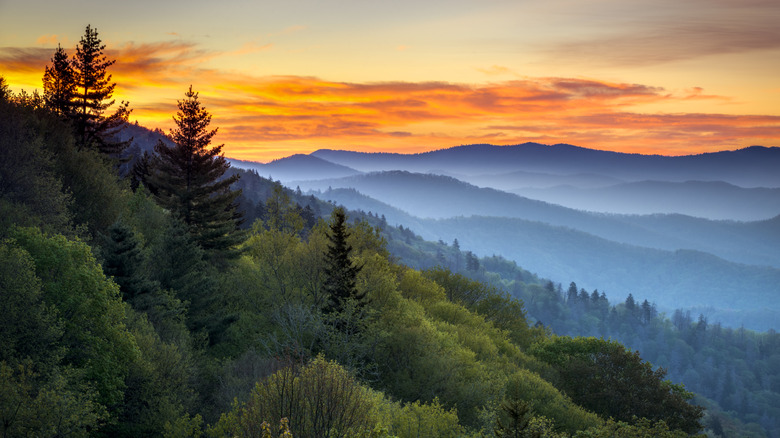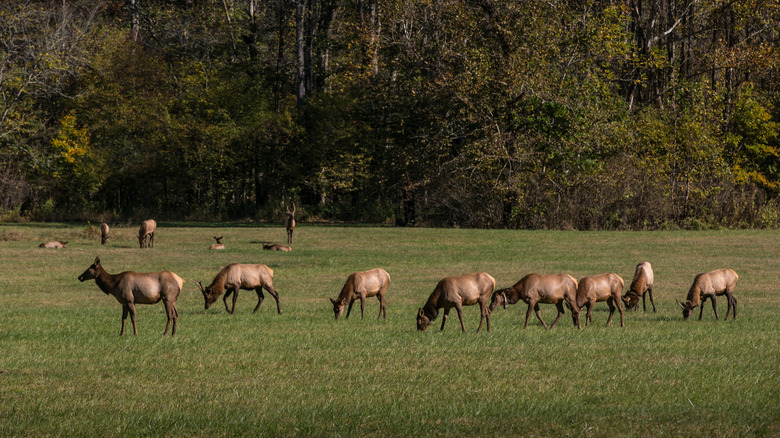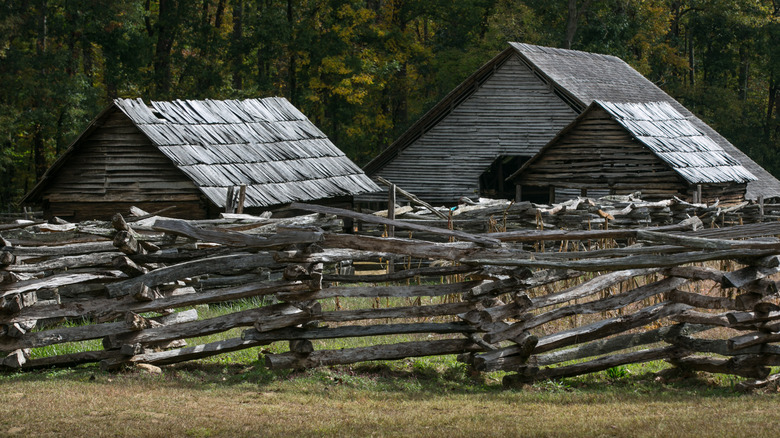The 'Southern Gateway To The Smokies' Is A Quiet, Wildlife-Filled Camping Getaway By Bryson City
There's something special about the Great Smoky Mountains. Take one look at the thick, blue haze that rests above the treetops — a true testament to the sheer magic and beauty of nature. From the bevy of wildlife that call the place home to the many historical gems that blanket the region, it's easy to see why the wilderness area is America's most visited national park.
The national treasure stretches across the border between Tennessee and North Carolina for more than 500,000 acres. Most visitors enter the park through Tennessee because the north entrance in Gatlinburg's Sugarlands area gets the most traffic. But the Oconaluftee area, North Carolina's southern gateway to the Smokies, is just as magnificent. The peaceful river valley teems with native wildlife and offers a slew of campsites for those who want to sleep beneath the stars.
Prefer a more pampered abode? Plenty of inns and lodges can be found just a stone's throw away in the small, storied North Carolina town of Cherokee, which is about an hour away from the Asheville Regional Airport (AVL). The Everett Hotel in the nearby, underrated mountain town of Bryson City is another great choice, boasting an "excellent" rating on Tripadvisor. In one review, a past guest described their stay as "a beautiful and sumptuous experience." "It was everything we could want — clean, and comfortable with outstanding hospitality and service," they said.
See the Oconaluftee Area's elk herd
A plethora of wild animals roam Great Smoky Mountains National Park, from burly bobcats and black bears to crafty coyotes and foxes. But the biggest animal by far is the elk, which can tower over its smaller deer cousins at upwards of 900 pounds. You can often glimpse these majestic creatures in the Oconaluftee Area, home to one of the park's two main elk herds — the other being the nearby Cataloochee Area.
You have a better chance at seeing the elk early in the morning or late in the night, when they're more active. According to Tripadvisor reviews, the herd can usually be spotted grazing about near the Oconaluftee Visitor Center, perched right off Newfound Gap Road. "Neat place to get close to wild elk in the evenings," one parkgoer wrote. "We watched 15-20 elk hanging out in the meadow beside the Visitor center. It was a really cool experience." Just don't get too close. Deliberately getting within 150 feet of elk is actually illegal and can result in a hefty fine or even time in jail, so be sure to take in the view from a safe distance, perhaps with a pair of binoculars.
While you're out on your Smoky Mountain excursion, keep your eyes peeled for the tiny critters, too. Known as the "Salamander Capital of the World," the park has more species of these tailed amphibians than anywhere else in the world. The twinkling fireflies are also a sight to behold.
Sleep under the stars in the Great Smokies
Once you're ready to call it a night, there are several options for setting up camp in Great Smoky Mountains National Park. Brave North Carolina's backcountry by popping a tent in one of the primitive camping sites scattered throughout the Oconaluftee Area, such as those found along the Cabin Flats and Lower Chasteen Creek Trails. Backcountry camping does require an advance reservation and a permit, which costs $8 per person, per night, as of this writing. Before venturing out, be sure to visit the National Park Service's website for potential hazards in the wilderness, from harsh weather conditions to bear activity.
If you're visiting with friends or family, hunker down in the Smokemont Campground, the closest group campground to the Oconaluftee Visitor Center. A couple of Smokemont's loops are open year-round, while the rest operate seasonally. The campground offers tent and RV sites, though there aren't any electric hookups or showers on the premises. Campsites currently cost $30 per night. While pricier than backcountry sites, it's still pretty affordable, considering the park doesn't charge an entrance fee. You will, however, have to pay for parking if you're driving in. Parking tags run $5 per day or $15 per week, at the time of writing. Be safe, and enjoy the view.


